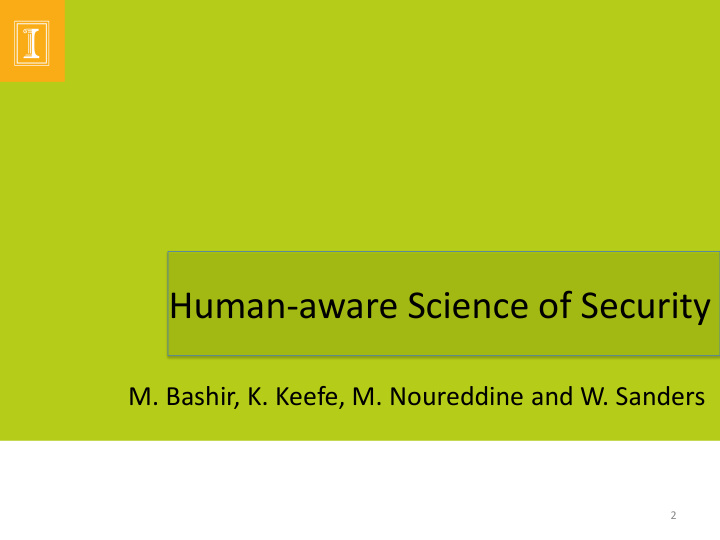



Human-aware Science of Security M. Bashir, K. Keefe, M. Noureddine and W. Sanders 2
The Science of Security • Current state of security research 1. Find a vulnerability 2. Fix it! 3. Introduce a new vulnerability or find another one 4. Fix it! Go to 3. • We need to study cyber security as a science – It’s not just a practice • We need to model and analyze security systems – How secure is a system? Under which conditions? Design systems that are resilient to known as well as • unknown threats or attacks
The Problem • According to the IBM security services report (2004), 95% of investigated security incidents involve human error. • Human users are regarded as the weakest link in the cyber security loop • “The problem exists between the chair and the keyboard” (PEBCAK) • We need to design and evaluate security systems with humans in the loop • An area often understudied in design of security systems
In the Literature • Two trends in human-aware security: Modeling and Usable security 1. Modeling: • Introduce a model of human decision in analogy with the central bank problem in economics [Beautement09] • Introduce security ontologies to define information and applications where human factors are vulnerabilities (based on some standards) [Parkin09] 2. Usable security: Design of human-centric security systems • Researchers noted usability issues since 1975 (Saltzer and Schroeder: “psychological acceptability”) • Most of the work focused on authentication and email encryption
Our Approach • Include models of human decision making in models of security systems • Evaluate the security (as well as performance) of systems in light of the uncertainty of human behavior • Current research: Human Influenced Task Oriented Process (HITOP) formalism • Goal: Use techniques from human factors, behavioral economics, human computer interaction (HCI), to design accurate models of human behavior
Human Influenced Task Oriented Process (HITOP) • We defined the HITOP[Eskins11] formalism – Model human actions as a set of tasks – Assumption: Humans tend to maximize local utilities – Define “human decision points” (HDP) where human decisions are important – In a HDP, human either willing to perform security action or not – Willingness related to local utility function[Eskins11] • We are looking to evaluate the accuracy of HITOP in modeling human decisions
Case Study • We will evaluate HITOP through a model of a nuclear power plant, influenced by Stuxnet
Methodology • Investigate literature in usable security, human factors, human computer interaction, etc. • Determine the variables that alter human behavior in favor of poor security decisions • Devise a model that allows us to simulate such decisions • Design a system model, an attacker model and a human user model • Use a simulation tool (Mobius) to evaluate the security (performance) of the system in light of all these variables
Relation to SoS • Understanding and studying security systems is incomplete without considering human factors • Understanding and modeling human behavior can help in – The assessment of the security of implemented systems – The design of new systems that are resilient to threats introduce by human elements
References [Beautement09] A. Beautement, R. Coles, J. Griffin, C. Ioannidis, B. • Monahan, D. Pym, A. Sasse, and M. Wonham, “Modelling the human and technological costs and benefits of usb memory stick security,” in Managing Informa- tion Risk and the Economics of Security . Springer, 2009, pp. 141–163. [Eskins11] D. Eskins and W. H. Sanders, “The multiple-asymmetric- • utility sys- tem model: A framework for modeling cyber-human systems,” in Quantitative Evaluation of Systems (QEST), 2011 Eighth International Conference on . IEEE, 2011, pp. 233–242. [Parkin09] S. E. Parkin, A. van Moorsel, and R. Coles, “An • information security ontology incorporating human-behavioural implications,” in Proceed- ings of the 2nd International Conference on Security of Information and Networks . ACM, 2009, pp. 46–55.
Recommend
More recommend